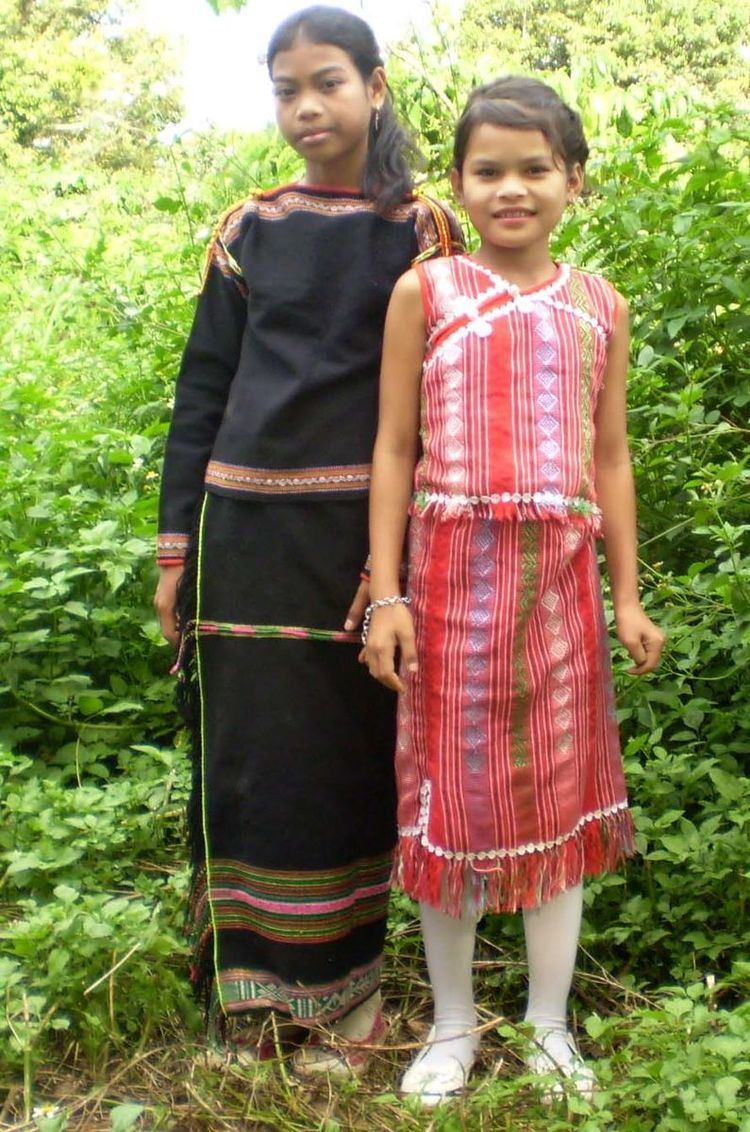 | ||
The Rade (also Ê Đê or Rhade) are an Austronesian ethnic group of southern Vietnam (population 270,348 in 1999).
Contents
Language
The Rade language is one of the Chamic languages, a subfamily of the Malayo-Polynesian branch of the Austronesian language family. Other Cham languages are spoken in central Vietnam and in Aceh, Sumatra; The Cham are more distantly to related to the Malayic languages of Indonesia, Malaysia and Madagascar and to the Philippine languages.
The Cham developed a writing system developed on the basis of the Latin script in the 1920s.
Kinship and Social Structure
The Rade practice matrilineal descent. Descent is traced through the female line, and family property is in the hands of and inherited from women. The basic kinship unit is the matrilineage; these are grouped into higher-level matrilineal sibs (matrisibs). The Rade are further divided into two phratries.
The women of a matrilineage and their spouses and children live together in a longhouse. The lineage holds corporate property such as paddy land, cattle, gongs, and jars; these are held by the senior female of the matrilineage. The lineage also engages in the farming of common lands and maintenance of the longhouse. The head of the longhouse itself is a man, with the position most commonly inherited by the spouse of the daughter or sister-in-law of the previous longhouse head.
Matrilineages and matrisibs are exogamous, with both sexual intercourse and marriage prohibited. The phratries also impose some restrictions on marriage. Couples violating these restrictions must sacrifice a buffalo, though violating phratry restrictions are generally not seen as being as serious, and require only the sacrifice of a pig. Residence is matrilocal.
Rade villages were traditionally autonomous and governed by an oligarchy of leading families. Some villages became locally dominant, but none formed any larger political structures.
Epic
Epics (Rade language: klei khan), such as Klei khan Y Dam San, H'Bia Mlin, Dam Kteh Mlan, Mdrong Dam, etc. are told by epic tellers (Rade language: po khan) next to the fire, through the night.
Music
Ede music is very diverse and playing music is the way that Ede people communicate to both other people, and according to their beliefs, God (Ede language: yang).
Musical instruments
Style of music
Architecture
A typical house of Rade people is the longhouse made of bamboo and wood. The longhouse's length is measured by the number of collar beams (Rade language: de). Once a girl living in the house gets married, the house is lengthened by one compartment, as the matrilocal aspect of Rade marriage means that the husband will live in his wife's house. The orientation of buildings are North-South.
The longhouse's space is divided into two parts: Gah part's area makes up 1/3- 2/3 the total area is considered as the living room and the other part includes bedrooms. There are two doors: the front door is for men, the back door is for women and two stairs: male stair and female stair.
Longhouses can be 100 meters long and house from three to nine families. A traditional description of the size of the longhouse is: "The house is as long as the gong's echo".
Vietnam War
During the Vietnam War, American and South Vietnamese military advisers feared that the Viet Cong would convert Rhade tribesman in the Darlac Province to their support. They instituted a program by which American Special Forces sought to train the Rhade in "village self-defense programs." The Rade made up a portion of the United States' Montagnard allies, and after the war some fled to the United States, mainly residing in North Carolina.
Notable Rade people
Customary law
L. Sabatier has collected 236 articles. The highest number of articles is of marriage and family matter, followed by property ownership and relationship between the head of villages and villagers. The main principles are that communal nature and equality are under guarantee. Judges are called khoa phat kdi.
